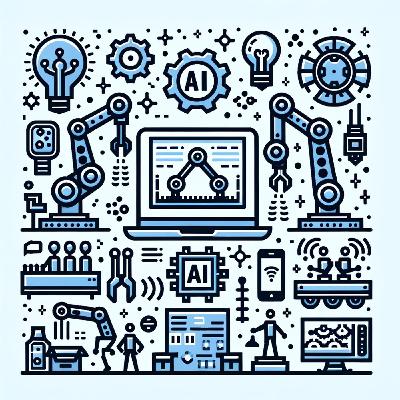Robots Steal Jobs & Hearts: AI's Steamy Factory Floor Takeover!
Update: 2025-11-21
Description
This is you Industrial Robotics Weekly: Manufacturing & AI Updates podcast.
Industrial automation is experiencing a dramatic transformation as manufacturing companies move full tilt into a new era, powered by artificial intelligence, machine learning, and next-level robotics. The global market value for industrial robot installations has reached a record high of sixteen and a half billion dollars, according to the International Federation of Robotics, with this surge reflecting strong investments in both manufacturing and warehouse automation. Autonomous mobile robots, robotic arms, and collaborative robots are now commonplace on factory floors and logistics hubs, driving a measurable leap in operational efficiency and accuracy.
Recent news highlights underscore this shift. The Association for Advancing Automation just reported North American companies ordered more than twenty-six thousand robots valued at 1.7 billion dollars in the third quarter of 2025, marking a significant jump over previous years and demonstrating ongoing growth in robot adoption for process optimization and cost reduction. At the same time, the deployment of AI-powered humanoid robots by companies like Tesla and Figure in advanced manufacturing settings is showing real-world potential to perform complex physical tasks, adapt to changing conditions, and collaborate safely with human workers.
Artificial intelligence now enables predictive maintenance, real-time process optimization, and adaptive scheduling, vastly reducing unplanned downtime and waste while supporting small-batch and custom production runs that were previously resource-intensive. Digital twins—virtual models of physical assets and production lines—are facilitating sophisticated simulations for quality assurance, bottleneck identification, and asset monitoring. This, combined with the Industrial Internet of Things, brings unprecedented supply chain visibility and agility, helping companies rapidly respond to shifts in demand, mitigate operational risks, and boost productivity.
Cost efficiency and return on investment are at all-time highs, with market data from IIOT World citing that the industrial robotics market is expected to nearly triple by 2035 to thirty-nine billion dollars, growing at a compound annual rate of seven and a half percent. This growth is driven by falling hardware costs and the rise of Robots-as-a-Service business models, making advanced automation accessible to small and medium enterprises.
Listeners seeking practical takeaways should prioritize investment in AI-driven automation, real-time sensing, and workforce training on collaborative robotics. Ensuring robust data infrastructure and exploring digital twin simulations can trim costs and futureproof operations. Looking ahead, the continued democratization of AI robotics, advances in human-machine collaboration, and strategic reshoring will define manufacturing competitiveness and resilience.
Thank you for tuning in to Industrial Robotics Weekly. Be sure to join us next week for more manufacturing and AI updates. This has been a Quiet Please production. For more, check out Quiet Please Dot A I.
For more http://www.quietplease.ai
Get the best deals https://amzn.to/3ODvOta
This content was created in partnership and with the help of Artificial Intelligence AI
Industrial automation is experiencing a dramatic transformation as manufacturing companies move full tilt into a new era, powered by artificial intelligence, machine learning, and next-level robotics. The global market value for industrial robot installations has reached a record high of sixteen and a half billion dollars, according to the International Federation of Robotics, with this surge reflecting strong investments in both manufacturing and warehouse automation. Autonomous mobile robots, robotic arms, and collaborative robots are now commonplace on factory floors and logistics hubs, driving a measurable leap in operational efficiency and accuracy.
Recent news highlights underscore this shift. The Association for Advancing Automation just reported North American companies ordered more than twenty-six thousand robots valued at 1.7 billion dollars in the third quarter of 2025, marking a significant jump over previous years and demonstrating ongoing growth in robot adoption for process optimization and cost reduction. At the same time, the deployment of AI-powered humanoid robots by companies like Tesla and Figure in advanced manufacturing settings is showing real-world potential to perform complex physical tasks, adapt to changing conditions, and collaborate safely with human workers.
Artificial intelligence now enables predictive maintenance, real-time process optimization, and adaptive scheduling, vastly reducing unplanned downtime and waste while supporting small-batch and custom production runs that were previously resource-intensive. Digital twins—virtual models of physical assets and production lines—are facilitating sophisticated simulations for quality assurance, bottleneck identification, and asset monitoring. This, combined with the Industrial Internet of Things, brings unprecedented supply chain visibility and agility, helping companies rapidly respond to shifts in demand, mitigate operational risks, and boost productivity.
Cost efficiency and return on investment are at all-time highs, with market data from IIOT World citing that the industrial robotics market is expected to nearly triple by 2035 to thirty-nine billion dollars, growing at a compound annual rate of seven and a half percent. This growth is driven by falling hardware costs and the rise of Robots-as-a-Service business models, making advanced automation accessible to small and medium enterprises.
Listeners seeking practical takeaways should prioritize investment in AI-driven automation, real-time sensing, and workforce training on collaborative robotics. Ensuring robust data infrastructure and exploring digital twin simulations can trim costs and futureproof operations. Looking ahead, the continued democratization of AI robotics, advances in human-machine collaboration, and strategic reshoring will define manufacturing competitiveness and resilience.
Thank you for tuning in to Industrial Robotics Weekly. Be sure to join us next week for more manufacturing and AI updates. This has been a Quiet Please production. For more, check out Quiet Please Dot A I.
For more http://www.quietplease.ai
Get the best deals https://amzn.to/3ODvOta
This content was created in partnership and with the help of Artificial Intelligence AI
Comments
In Channel





